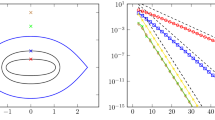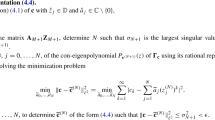Abstract
An effective means to approximate an analytic, nonperiodic function on a bounded interval is by using a Fourier series on a larger domain. When constructed appropriately, this so-called Fourier extension is known to converge geometrically fast in the truncation parameter. Unfortunately, computing a Fourier extension requires solving an ill-conditioned linear system, and hence one might expect such rapid convergence to be destroyed when carrying out computations in finite precision. The purpose of this paper is to show that this is not the case. Specifically, we show that Fourier extensions are actually numerically stable when implemented in finite arithmetic, and achieve a convergence rate that is at least superalgebraic. Thus, in this instance, ill-conditioning of the linear system does not prohibit a good approximation.
In the second part of this paper we consider the issue of computing Fourier extensions from equispaced data. A result of Platte et al. (SIAM Rev. 53(2):308–318, 2011) states that no method for this problem can be both numerically stable and exponentially convergent. We explain how Fourier extensions relate to this theoretical barrier, and demonstrate that they are particularly well suited for this problem: namely, they obtain at least superalgebraic convergence in a numerically stable manner.















Similar content being viewed by others
Notes
The constant of growth was obtained in private communication with A. Kuijlaars. A closed expression (up to several integrals involving the potential function ϕ for the nodes z n ) can be found for c(γ;T). We omit the full argument as it is rather lengthy, but note that it is based on standard results in potential theory. A general reference is [29].
Abbreviations
- T :
-
Extension parameter
- N :
-
Truncation parameter
- M, γ :
-
Number of equispaced nodes of the equispaced FE, and the oversampling parameter γ=M/N
- ϕ n (x):
-
The exponential \(\frac{1}{\sqrt{2T}} \mathrm{e}^{{\mathrm{i}}\frac{n \pi}{T} x } \)
- \(\mathcal {G}_{N} \), \(\mathcal {S}_{N}\), \(\mathcal {C}_{N}\) :
-
Finite-dimensional spaces of exponentials, sines and cosines
- F N , \(\tilde{F}_{N}(f)\), F N,M (f):
-
Exact continuous, discrete and equispaced FEs
- G N , \(\tilde{G}_{N}(f)\), G N,M (f):
-
Numerical continuous, discrete and equispaced FEs
- a :
-
Vector of coefficients of an FE
- A, \(\tilde{A}\), \(\bar{A}\) :
-
Matrices of the continuous, discrete and equispaced FE’s
- b, \(\tilde{b}\), \(\bar{b}\) :
-
Data vectors for the continuous, discrete and equispaced FEs
- x, y, z :
-
Physical domain variable x∈[−1,1], and the mapped variables y∈[c(T),1] and z∈[−1,1]
- f e(x), f o(x):
-
Even and odd parts of the function f(x)
- g 1(y), g 2(y), g 1,N (y), g 2,N (y):
-
Images of f e(x) and \(f_{\mathrm{o}}(x) / \sin \frac{\pi}{T} x\) in the y-domain and their polynomial approximations
- h i (z), h i,N (z):
-
Images of g i and g i,N in the z-domain
- m(x):
-
The mapping x↦z
- c(T), E(T):
-
FE constants \(\cos \frac{\pi}{T}\) and \(\cot^{2} ( \frac{\pi}{4 T} )\).
- \(\mathcal {B}(\rho) \), \(\mathcal {D}(\rho)\) :
-
Bernstein ellipse in the z-domain and its image in the x-domain
- κ(F):
-
Condition number of a mapping F
- N 0, N 1, N 2 :
-
Breakpoints in convergence
- {u n ,σ n ,v n }:
-
Singular system of A, \(\tilde{A}\) or \(\bar{A}\)
- Φ n :
-
Fourier series corresponding to v n
- \(\mathcal {G}_{N,\epsilon} \), \(\mathcal {G}'_{N,\epsilon} \), \(\mathcal {G}_{N,M,\epsilon}\) :
-
The subspace span{Φ n :σ n >ϵ}
- H N,ϵ (f), \(\tilde{H}_{N,\epsilon}(f)\), H N,M,ϵ (f):
-
Truncated SVD FEs corresponding to the continuous, discrete and equispaced cases
- a(γ;T):
-
Quantity determining the maximal achievable accuracy of the equispaced FE
- L2(I), 〈⋅,⋅〉 I , ∥⋅∥ I :
-
Space of square-integral functions on a domain I and corresponding inner product and norm
- 〈⋅,⋅〉, ∥⋅∥:
-
Inner product and norm on L2(−1,1)
- \(\mathrm {L}^{2}_{w}(I)\), 〈⋅,⋅〉 w,I , ∥⋅∥ w,I :
-
Space of square integrable functions with respect to a weight function w and corresponding inner product and norm
- ∥⋅∥∞,I , ∥⋅∥∞ :
-
Uniform norms on an arbitrary domain I and the interval [−1,1] respectively
References
B. Adcock, D. Huybrechs, On the resolution power of Fourier extensions for oscillatory functions. Technical Report TW597, Dept. Computer Science, K.U. Leuven, 2011.
N. Albin, O.P. Bruno, A spectral FC solver for the compressible Navier–Stokes equations in general domains. I: Explicit time-stepping, J. Comput. Phys. 230(16), 6248–6270 (2011).
H. Bateman, Higher Transcendental Functions, vol. 2 (McGraw–Hill, New York, 1953).
J.P. Boyd, Chebyshev and Fourier Spectral Methods (Springer, Berlin, 1989).
J.P. Boyd, A comparison of numerical algorithms for Fourier extension of the first, second, and third kinds, J. Comput. Phys. 178, 118–160 (2002).
J. Boyd, Fourier embedded domain methods: extending a function defined on an irregular region to a rectangle so that the extension is spatially periodic and C ∞, Appl. Math. Comput. 161(2), 591–597 (2005).
J.P. Boyd, Trouble with Gegenbauer reconstruction for defeating Gibbs phenomenon: Runge phenomenon in the diagonal limit of Gegenbauer polynomial approximations, J. Comput. Phys. 204(1), 253–264 (2005).
J.P. Boyd, J.R. Ong, Exponentially-convergent strategies for defeating the Runge phenomenon for the approximation of non-periodic functions. I. Single-interval schemes, Commun. Comput. Phys. 5(2–4), 484–497 (2009).
J. Boyd, F. Xu, Divergence (Runge phenomenon) for least-squares polynomial approximation on an equispaced grid and Mock–Chebyshev subset interpolation, Appl. Math. Comput. 210(1), 158–168 (2009).
O.P. Bruno, Fast, high-order, high-frequency integral methods for computational acoustics and electromagnetics, in Topics in Computational Wave Propagation: Direct and Inverse Problems, ed. by M. Ainsworth et al. Lecture Notes in Computational Science and Engineering, vol. 31 (Springer, Berlin, 2003), pp. 43–82.
O. Bruno, M. Lyon, High-order unconditionally stable FC–AD solvers for general smooth domains. I. Basic elements, J. Comput. Phys. 229(6), 2009–2033 (2010).
O.P. Bruno, Y. Han, M.M. Pohlman, Accurate, high-order representation of complex three-dimensional surfaces via Fourier continuation analysis, J. Comput. Phys. 227(2), 1094–1125 (2007).
C. Canuto, M.Y. Hussaini, A. Quarteroni, T.A. Zang, Spectral Methods: Fundamentals in Single Domains (Springer, Berlin, 2006).
O. Christensen, An Introduction to Frames and Riesz Bases (Birkhauser, Basel, 2003).
D. Coppersmith, T. Rivlin, The growth of polynomials bounded at equally spaced points, SIAM J. Math. Anal. 23, 970–983 (1992).
R.J. Duffin, A.C. Schaeffer, A class of nonharmonic Fourier series, Trans. Am. Math. Soc. 72, 341–366 (1952).
A. Edelman, P. McCorquodale, S. Toledo, The future Fast Fourier Transform? SIAM J. Sci. Comput. 20(3), 1094–1114 (1999).
B. Fornberg, A Practical Guide to Pseudospectral Methods (Cambridge University Press, Cambridge, 1996).
D. Gottlieb, S.A. Orszag, Numerical Analysis of Spectral Methods: Theory and Applications, 1st edn. (SIAM, Philadelphia, 1977).
D. Gottlieb, C.-W. Shu, On the Gibbs’ phenomenon and its resolution, SIAM Rev. 39(4), 644–668 (1997).
D. Gottlieb, C.-W. Shu, A. Solomonoff, H. Vandeven, On the Gibbs phenomenon. I: Recovering exponential accuracy from the Fourier partial sum of a nonperiodic analytic function, J. Comput. Appl. Math. 43(1–2), 91–98 (1992).
D. Huybrechs, On the Fourier extension of non-periodic functions, SIAM J. Numer. Anal. 47(6), 4326–4355 (2010).
D. Kosloff, H. Tal-Ezer, A modified Chebyshev pseudospectral method with an \(\mathcal {O}(N^{-1})\) time step restriction, J. Comput. Phys. 104, 457–469 (1993).
M. Lyon, Approximation error in regularized SVD-based Fourier continuations, Appl. Numer. Math. 62, 1790–1803 (2012).
M. Lyon, A fast algorithm for Fourier continuation, SIAM J. Sci. Comput. 33(6), 3241–3260 (2012).
M. Lyon, O. Bruno, High-order unconditionally stable FC–AD solvers for general smooth domains. II. Elliptic, parabolic and hyperbolic PDEs; theoretical considerations, J. Comput. Phys. 229(9), 3358–3381 (2010).
R. Pasquetti, M. Elghaoui, A spectral embedding method applied to the advection–diffusion equation, J. Comput. Phys. 125, 464–476 (1996).
R. Platte, L.N. Trefethen, A. Kuijlaars, Impossibility of fast stable approximation of analytic functions from equispaced samples, SIAM Rev. 53(2), 308–318 (2011).
T. Ransford, Potential Theory in the Complex Plane (Cambridge Univ. Press, Cambridge, 1995).
T.J. Rivlin, Chebyshev Polynomials: From Approximation Theory to Algebra and Number Theory (Wiley, New York, 1990).
D. Slepian, Prolate spheroidal wave functions. Fourier analysis, and uncertainty. V: The discrete case, Bell Syst. Tech. J. 57, 1371–1430 (1978).
L.N. Trefethen, D. Bau, Numerical Linear Algebra (SIAM, Philadelphia, 1997).
J. Varah, The prolate matrix, Linear Algebra Appl. 187(1), 269–278 (1993).
Acknowledgements
The authors would like to thank John Boyd, Doug Cochran, Laurent Demanet, Anne Gelb, Anders Hansen, Arieh Iserles, Arno Kuijlaars, Mark Lyon, Nilima Nigam, Sheehan Olver, Rodrigo Platte, Jie Shen and Nick Trefethen for useful discussions and comments. They would also like to thank the anonymous referees for their constructive and helpful remarks.
Author information
Authors and Affiliations
Corresponding author
Additional information
Communicated by Nira Dyn.
Rights and permissions
About this article
Cite this article
Adcock, B., Huybrechs, D. & Martín-Vaquero, J. On the Numerical Stability of Fourier Extensions. Found Comput Math 14, 635–687 (2014). https://doi.org/10.1007/s10208-013-9158-8
Received:
Revised:
Accepted:
Published:
Issue Date:
DOI: https://doi.org/10.1007/s10208-013-9158-8




